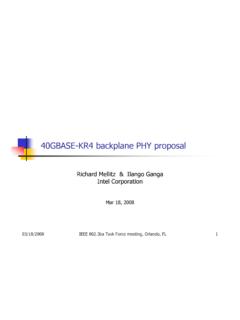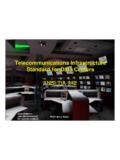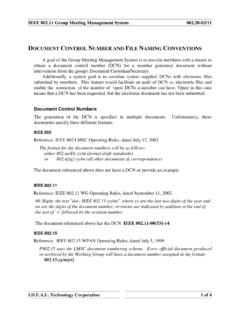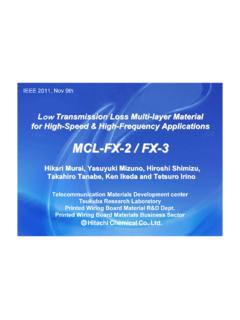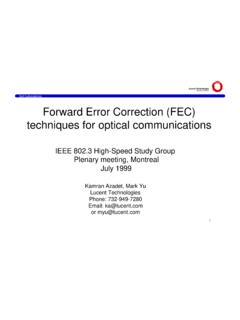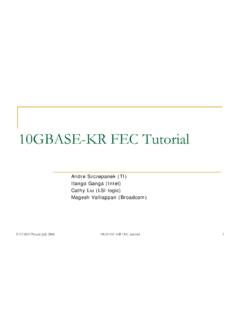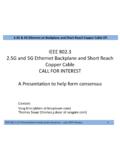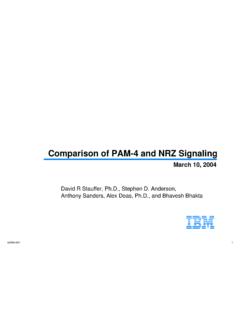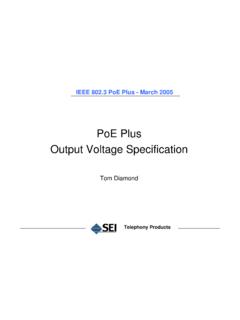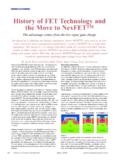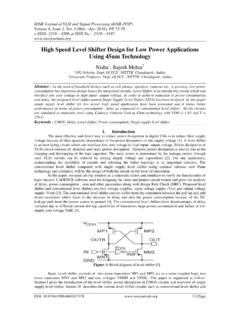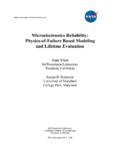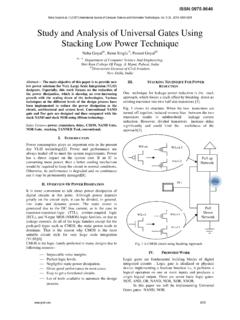Transcription of PAM4 digital receiver performance and feasibility - …
1 pam4 digital receiver performance and feasibilitypyVasu ParthasarathyJan 2012 Jan and Contributors Howard Frazier, Broadcom Will Bliss, Broadcom Kent Lusted, Intel Rich Mellitz Intel Rich Mellitz, Intel Sanjay Kasturia, Inphi Hamid Rategh, Inphi Adee Ran, Intel Matt Brown, Applied MicroObjectives Explore pam4 performance on channels submitted to .ap as well as recent submissions These channels have generally been accepted as difficult for most line These channels have generally been accepted as difficult for most line codes Evaluate tradeoffs between complexity and performance with a digital ADC based receiver architectureADC based receiver architecture Demonstrate technical feasibility of the architecture for supporting 100 Gbps operation100 GBASE-KR4 digital Transceiver Block DiagramTxdeemphDriverTxPre-coderith blkPMA fFECdde-emphwith block terminationframerencoder TIMING RECOVERY-ePre-coder dd/FECVGAADCFFESLICER+FECCTF decoder/FECDFEeeeSimulation Setup digital receiver Architecture3 t FFE (1 1 i 1 t) ki filt ( 8db bt t Nit) ADC 32 t FFE 2 t 3 tap FFE (1 pre,1 main, 1 post), peaking filter (~8db boost at Nyquist)
2 , ADC, 32 tap FFE, 2 tap DFE, 5 dB FEC at an increased line-rate of Gbps (accounts for FEC overhead) Simulation ParametersSimulation Parameters Tx Launch = 1 Vppd Trise/fall = 20ps Tx RJ = ps rmsTXDJ 0 0 UI kk TXDJ = peak-peak Rx RJ = ps rms AWGN PSD = -154 dBm/Hz double-sided Package Model: s-parameters from current 10 GBASE-KR production package (corresponds to a gpppg(psmall chip package model) SNR Target = dB (corresponds to BER = 10-12)Channel 1: Molex1channel (crosstalk scaled by 8 dB)SNR margin (for 10-12 BER ) vs ADC ENOB ( receiver complexity)_____1 2: TE Connectivity2channel with Nelco4000-6 SNR margin (for 10-12 BER ) vs ADC ENOB ( receiver complexity)_____2 3: Emerson3channel SNR margin (for 10-12 BER ) vs ADC ENOB ( receiver complexity)_____3 ( )Transmitter feasibility Transmitters have been built with 10 taps of de-emphasis for NRZ designs at 10 Gbps4 Litt t f 5 t dhi pam4 titt t 20 Gb56 Literature reports of an 5 tap de-emphasis pam4 transmitter at 20 Gbps5,6 High precision DAC s have been fabricated around rates of 24 Gbps (12 Gsamples/sec)7 pam4 transmitter with 3 tap deemphasis should be feasible in current technology pam4 transmitter with 3 tap de-emphasis should be feasible in current technology at a reasonable et.)
3 Al., Architecture and Experimental Evaluation of a 10Gb/s MLSD based Transceiver for Optical Multimode applications , Proceedings of ICC, May et. al., A 10 Gb/s Wire-line Transceiver with Half Rate Period Calibration CDR , Proceedings of IEEE ISCAS, May et. al., A 24 Gb/s Software Programmable Analog Multi-Tone Transmitter , IEEE Journal of solid state circuits, April 20087 Greshishchev, et. al., A 56GS/S 6b DAC in 65nm CMOS with 256 6b memory , Proceedings of the IEEE ISSCC, April 2011 Existing 6bit ADCTI-4TI-3 ADC4X ti i t li (2 5G bADC)TI-2TI14 x GS/s10 GS/sData 4X time interleaving ( subADCs) 6 bit ADC ENOB 5bit 65nm CMOS processTI-1T/H6-bitsubADCCLK1[C ISSCC09 21 7 6b 10 GS/ ADC] Power = 330mW ISSCC 200910 GS/s Data100 psCLK1[Cao ISSCC09, , 6b 10 GS/s ADC] 28nm provides ~ 50% power savingENOB 6 i 2 CLK1 CLK2 CLK3 CLK4Ot1 ENOB=6 requires ~ 2x more power 28nm 7bit ADC power ~ 430mWOut1 Out2 Out3 Out4 Existing 40GS/s 6 bit ADC 40GS/s ADC 16X time interleaving (2 5G subADCs)16X time interleaving ( subADCs)
4 6 bit ADC ENOB 5bit 65nm CMOS processPo er 1500mW Power = 1500mW ISSCC 2010 28nm provides ~ 50% power saving 13 5G ADC requires ~ 66% less power[Greshishchev ISSCC10, , - 6b 40 GS/s ADC] ADC requires 66% less power ENOB=6 requires ~ 2x more power 28nm 7bit 13 5G ADC power 500mW 28nm 7bit ADC power ~ 500mWExisting 63GS/s 8 bit ADC 63GS/s ADC 320X time interleaving320X time interleaving 8 bit ADC ENOB 6bit 40nm CMOS processPo er 1250mW Power = 1250mW OFC 2010 28nm provides ~ 30% power saving 13 5G ADC requires ~ 76% less ADC requires 76% less power 28nm 8bit ADC power ~ 190mWADC feasibility .. 10-50G ADCs with 5-6 bit ENOB have been successfully implemented as well as presented in major conferences 7bit ADC power can be in 190-500mW range depending on the architectural and circuit implementation Further improvements in ADC is possible with architectural considerations tailored towards the pam4 situationEqualizer (FFE) feasibility Synthesized a parallelized 32 tap FFE with 40nm std cell TSMC library (effective bit-rate is around 26 Gbps) Develops on a Fast FFE implementation8 Production part type synthesis with 20% timing margin to worst PVT corner (to estimate feasibility , area and power)co e (to estate eas b ty, a ea a d po e ) Straightforward Fast FFE implementation, further optimizations possible in tap widths and adders for smaller area, power and latency POWER (Synopsys DC estimated prelayout static + dynamic).
5 Around POWER (Synopsys DC estimated pre-layout, static + dynamic): around twice that of a 10 tap KR FFE implementation at Gbps Process node change to 28nm/20nm would further reduce the FFE b t lt 30%power by at least 30%_____8 Richard Blahut, Fast Algorithms for digital Signal Processing , Addison-Wesley, 1985 Equalizer (DFE) feasibility Synthesized a 2 tap look-ahead9 pam4 DFE with 40nm std cell library (effective bit-rate is around 26 Gbps) Production part type synthesis with 20% timing margin to worst PVT Production part type synthesis with 20% timing margin to worst PVT corner (to estimate feasibility , area and power) Straightforward implementation used, further optimizations possible in look-ahead structure for lower area/power/latencylook-ahead structure for lower area/power/latency Note that some amount of duty-cycle distortion (DCD) can be cancelled with a look-ahead DFE architecturePOWER (S DC tit d lt tti d i)
6 Iil POWER (Synopsys DC estimated pre-layout, static + dynamic) : similar to a 4 tap NRZ DFE at KR rates of Gbps Process node change to 28nm/20nm would further reduce the FFE power by at least 30%_____9 Keshab K. Parhi, Design of Multigigabit Multiplexer-Loop-Based Decision Feedback Equalizers , IEEE Transactions O V L S l I tti (VLSI) t V l 13 N 4 A il 2005On Very Large Scale Integration (VLSI) systems, Vol. 13, , April 2005 Other blocks .. PGA adaptation blocks typically run at low speed (highly sub-sampled line-rate clock) LMS adaptation for stationary channels also typically run at very low speeds Timing recovery algorithms10for pam4 are relatively simple to gygypimplement FEC block codes which provide 5 dB coding gain are readily available and have been presented at IEEE11, 12and have been presented at IEEE These codes have been analyzed in detail and shown to be low in power and area irrespective of the choice of line code_____10K.
7 H. Mueller and M. S. Muller, Timing Recovery in digital Synchronous Data Receivers ,IEEET ransactions on Communications, vol. COM-24, pp. 516-531, May et. al., Precoding proposal for pam4 modulation , IEEE Chicago meeting, Sept. 2011 and , feasibility of 100G-KR FEC , IEEE Lake Tahoe meeting,May 2011 Prior work .. digital receiver performance over KR-compliant installed base13 Coverage explored here with the digital architecture on a installed base f KR lit hl l t d th lt f of KR compliant channels accumulated over the last few years Full coverage on the installed base et. al., feasibility of 100 Gb/s operation on installed backplane channels, IEEE Lake Tahoe meeting, May 2011 Conclusions Demonstrated that it is technically feasible to by use pam4 as the line d/ dlti t hicode/modulation technique Examined the performance of a digital pam4 receiver architectures over pgsome channels submitted to IEEE All of the major blocks required for an implementation are technically All of the major blocks required for an implementation are technically and economically feasible using current technology
